Top 5 Free Mind Maps Examples and Tools to Help Unleash Your Creativity and Productivity in 2023 (price & feature)

What is mind maps?
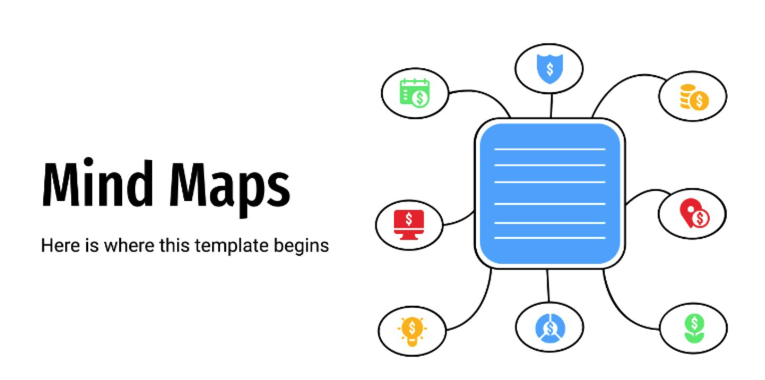
Mind maps are powerful visual tools that aid individuals in organizing, structuring, and connecting ideas and information. They provide a creative and intuitive way to represent thoughts and concepts, allowing for a more comprehensive and interconnected understanding.
At the heart of a mind map is a central topic or idea, serving as the focal point. From there, branches extend outward, representing related subtopics and details. This hierarchical structure allows for a clear organization of information, with the central idea serving as the main theme and the branches serving as pathways to explore supporting ideas.
Mind maps utilize various visual elements to enhance comprehension and engagement. Colors are employed to categorize and differentiate concepts, helping to create a visually stimulating representation. Symbols and images are used to emphasize key points and establish connections between different elements, aiding in the visualization of relationships.
By harnessing the power of spatial and visual thinking, mind maps encourage a more holistic and creative approach to problem-solving and information processing. They tap into the brain's natural inclination for patterns, associations, and visual cues, facilitating a deeper understanding and stimulating new ideas and perspectives.

Benefits of mind maps:

-
Stimulates creativity and idea generation: The visual and non-linear nature of mind maps encourages free-flowing thinking and the generation of innovative ideas.
-
Enhances learning and information retention: Mind maps engage both the left and right hemispheres of the brain, promoting active learning and improving memory recall.
-
Facilitates effective organization and planning: The hierarchical structure of mind maps allows for the organization of complex information into manageable and structured formats, aiding in planning and decision-making processes.
-
Improves problem-solving skills: Mind maps help identify and analyze relationships between different elements, facilitating a systematic approach to problem-solving.
-
Enhances note-taking and summarization: Mind maps capture information in a concise and visual manner, making it easier to review and summarize complex topics.
-
Supports efficient collaboration and communication: Mind maps serve as a collaborative tool, enabling teams to brainstorm, share ideas, and present information in a clear and accessible format.
-
Assists in personal development and goal setting: Mind maps can be used to map out personal goals, track progress, and identify actionable steps towards personal growth and achievement.
-
Helps with time management and productivity: Mind maps enable effective planning, prioritization, and time allocation, promoting productivity and efficient task management.
Five most popular Mind Maps examples:
After the introduction to mind maps, you may discover how the top five mind maps examples below can transform your personal and professional life.
1. Project Planning
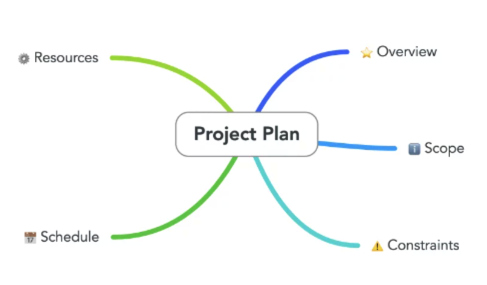
Targeted users: project managers, software engineers, business analysts, team leaders, etc.
-
Software Development Project: In software development projects, mind maps are utilized to plan and track the project from start to finish. Project managers, software engineers, and team leaders can use a mind map to define the project scope, break down tasks and milestones, assign responsibilities to team members, and identify dependencies between different components. This visual representation helps them gain a comprehensive overview of the project and ensures effective coordination and collaboration.
-
Business Process Improvement: Mind maps are valuable tools for analyzing and improving existing business processes. Professionals such as business analysts and team leaders can create mind maps to visually map out the current workflow, identify bottlenecks and inefficiencies, and brainstorm potential solutions. By prioritizing improvement initiatives and tracking progress, they can implement changes that optimize efficiency and productivity within the organization.
-
Event Planning: Event planners can leverage mind maps to manage all aspects of an event, whether it's a conference, workshop, or seminar. They can use the mind map to plan and coordinate activities such as venue selection, speaker coordination, agenda planning, logistics management, and marketing activities. The mind map serves as a central reference point, enabling event planners to keep track of all essential details and ensure a smooth and successful event.
-
Product Development: Mind maps play a vital role in product development processes. Product managers, software engineers, and design teams can utilize mind maps to define product features, prioritize requirements, create user stories, and track progress throughout the development lifecycle. The visual representation provided by the mind map helps them communicate and collaborate effectively, ensuring that all stakeholders have a shared understanding of the product vision and goals.
2.Learning and Studying
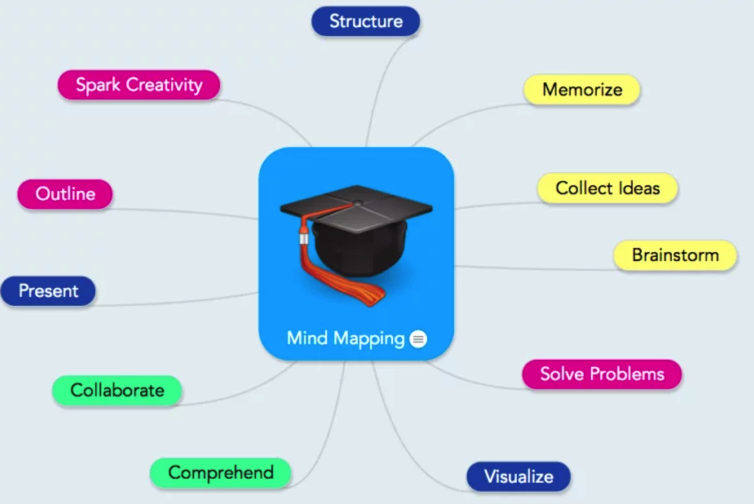
Targeted users: students, educators, researchers, etc.
-
Exam Preparation: When preparing for exams, students can use mind maps to organize key topics, subtopics, and related concepts. By visually connecting different ideas and creating associations, mind maps facilitate effective learning and retention. Students can create a comprehensive overview of the subject matter, making it easier to review and grasp the interconnectedness of different concepts.
-
Research Project: Researchers can utilize mind maps to organize their sources, theories, and arguments while working on a research project. Mind maps allow them to see the relationships between different art movements, influential artists, or any other research topic. This visual representation aids in the development of their research paper by providing a clear structure and helping them identify gaps or areas that require further exploration.
-
Lecture Note-Taking: During lectures, students can use mind maps to take notes and capture the main ideas, supporting evidence, and related theories discussed. The hierarchical structure of mind maps helps them organize information in a structured and visually appealing manner. This makes it easier to review and study later, as they can easily navigate through the key points and connections made during the lecture.
-
Thesis Planning: When planning a thesis, students can create a mind map to outline the research question, objectives, methodology, and key sections of their thesis. The mind map serves as a guide throughout the entire thesis-writing process, helping them stay focused and organized. By visually mapping out their thesis structure and the connections between different sections, students can effectively manage their research journey.
3.Brainstorming and Idea Generation
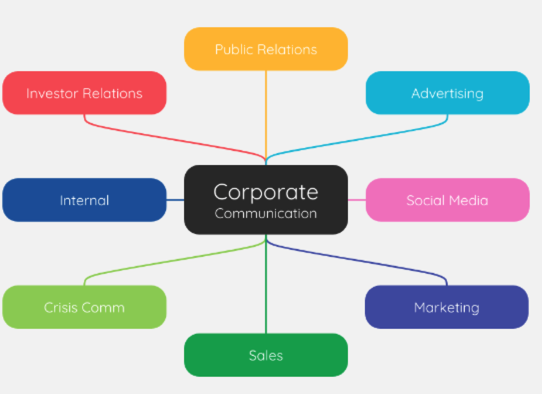
Targeted users: creative professionals, marketers, entrepreneurs, innovation teams, group workers, etc.
-
Creative Marketing Campaign: When developing a marketing campaign, creative professionals and marketers can use mind maps to generate innovative ideas. Mind maps allow them to visualize connections between different concepts, brainstorm various campaign elements, and refine their approach. This visual representation helps them explore different angles, messaging strategies, and creative elements to create impactful marketing campaigns.
-
Product Innovation: For product innovation, entrepreneurs and product development teams can utilize mind maps to explore possibilities and evaluate the benefits and challenges of different ideas. They can map out features, functionalities, target audience, and potential synergies with existing product offerings. Mind maps provide a visual framework for idea generation, allowing them to refine and prioritize concepts for further development.
-
Business Startup Planning: Entrepreneurs planning a business startup can use mind maps to brainstorm and map out business ideas, target markets, and outline the business model. They can explore different aspects such as product or service offerings, customer segments, revenue streams, and marketing strategies. Mind maps help in organizing and connecting various elements of the startup plan, facilitating a clear and comprehensive overview.
-
Design Ideation: Designers and creative teams can employ mind maps to explore design elements, such as color palettes, typography options, visual styles, and layout ideas. Mind maps enable them to visualize different design approaches, create associations between design elements, and generate new ideas. This aids in the ideation process and helps in refining design concepts for various projects.
-
Team Collaboration: Mind maps serve as one of the Top Collaboration Tools for Teams to Drive Success. Whether it's brainstorming sessions, knowledge sharing, or aligning efforts, a visual and collaborative mind map platform enables teams to brainstorm ideas collectively. By capturing and organizing ideas in a centralized and interactive manner, teams can collaborate effectively, build upon each other's contributions, and create a shared understanding.
4.Decision Making
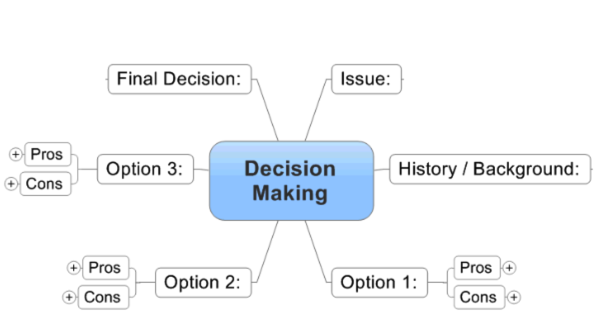
Targeted users: business owners, executives, managers, consultants, etc.
-
Business Strategy: When making strategic decisions, such as entering new markets or launching new products, business owners, executives, and managers can use mind maps to evaluate options. They can weigh the pros and cons of different strategies, consider market trends and competitive landscape, and analyze potential risks and rewards. Mind maps provide a visual representation of the decision-making factors, allowing them to assess different scenarios and make informed strategic choices.
-
Project Prioritization: Managers and team leaders can utilize mind maps to assess project requirements, dependencies, and deadlines. They can prioritize tasks, allocate resources effectively, and ensure timely project completion. By visually representing project elements and their relationships, mind maps enable decision-makers to gain clarity and make informed decisions about task priorities, resource allocation, and project sequencing.
-
Product Selection: When selecting products or services for a business, decision-makers can use mind maps to compare features, prices, and customer reviews. Mind maps help them organize and visualize the evaluation criteria, allowing for a comprehensive and systematic assessment. By mapping out the key attributes and weighing the factors, decision-makers can make informed purchasing decisions and choose the best products or services for their needs.
-
Career Path Planning: Individuals planning their career paths can use mind maps to explore different industries, job roles, and required skills. They can map out their interests, strengths, and aspirations, and identify potential career paths. Mind maps provide a structured framework for considering various options, visualizing career progression, and aligning personal goals with professional development opportunities.
-
Investment Analysis: Investors and financial professionals can employ mind maps to assess risks, potential returns, market trends, and financial indicators. They can visually represent different investment options, evaluate the factors influencing investment decisions, and analyze the potential outcomes. Mind maps aid in organizing and connecting financial information, enabling decision-makers to make well-informed investment choices.
5.Personal Organization

Targeted users: Professionals, individuals seeking personal growth, entrepreneurs, freelancers, etc.
-
Daily Task Management: Professionals and individuals seeking personal organization can utilize mind maps to organize their daily tasks, priorities, and deadlines. They can create a visual representation of their to-do lists, categorize tasks based on urgency or importance, and track progress. Mind maps provide a clear overview of the tasks at hand, helping individuals stay focused and productive throughout the day.
-
Event Planning: When organizing an event, such as a party, conference, or wedding, individuals can use mind maps to plan and manage all aspects of the event. They can create branches for tasks, schedules, vendors, and logistics, ensuring nothing is overlooked. Mind maps allow for efficient collaboration, as multiple stakeholders can contribute ideas and updates to the visual representation, ensuring seamless event planning and execution.
-
Goal Setting: Mind maps are a powerful tool for setting and achieving goals. Individuals can break down their goals into actionable steps and set deadlines for each milestone. By visually mapping out the necessary actions and tracking progress, individuals can stay motivated and focused on achieving their goals. Mind maps serve as a constant reminder of the desired outcomes and provide a roadmap for personal growth and success.
-
Travel Planning: When planning a trip, individuals can use mind maps to organize their itinerary, research destinations, and keep track of travel-related information. They can create branches for flights, accommodations, sightseeing, transportation, and other key aspects. Mind maps help in visualizing the overall travel plan, making it easier to adjust and refine the itinerary. By organizing all travel-related information in one place, individuals can ensure a smooth and enjoyable travel experience.
Recommendation of Mind Maps ToolsReady to dive into the world of mind maps? Discover the top recommended tools that will ignite your creativity and supercharge your productivity. Explore a range of popular options and find the perfect mind mapping tool to bring your ideas to life.
Recommendation of Mind Maps Tools
Ready to dive into the world of mind maps?
Discover the top recommended tools that will ignite your creativity and supercharge your productivity. Explore a range of popular options and find the perfect mind mapping tool to bring your ideas to life.
1.AFFiNE

Ease of Use:⭐️ ⭐️ ⭐️ ⭐️ ⭐️ Visual Appeal:⭐️ ⭐️ ⭐️ ⭐️ ⭐️ Functionality and Features:⭐️ ⭐️ ⭐️ ⭐️
Price: FREE
AFFiNE is a next-gen knowledge base that brings planning, sorting, and creating all together in the workspace. It offers a range of powerful features that enhance productivity, with its fantastic mind maps being a standout feature. For instance,
Local first approach: One of the key strengths of AFFiNE is its support for offline working. This means you can create and work on your mind maps at any time, even when you don't have an internet connection. This flexibility allows you to capture your ideas and thoughts whenever inspiration strikes, ensuring that no brilliant idea goes to waste. Additionally, AFFiNE prioritizes data security, keeping your information safe and private. You can download the newest version and give it a shot: What's new - AFFiNE- 20230518 | AFFiNE.
Shifting between two modes: You start in the Whiteboard, freely connecting and arranging your thoughts, creating a visual representation of your ideas. However, as you delve deeper into a particular subtopic, you realize the need to capture more detailed information. This is where shifting to page mode becomes beneficial, which allows you edit the detailed information in a more linear manner by shifting to page mode. More surprisingly, AFFiNE can also allow you to insert Database in the mind map! This versatility allows you to explore your ideas at both a high-level overview and a granular detail, ensuring a comprehensive representation of your thoughts.

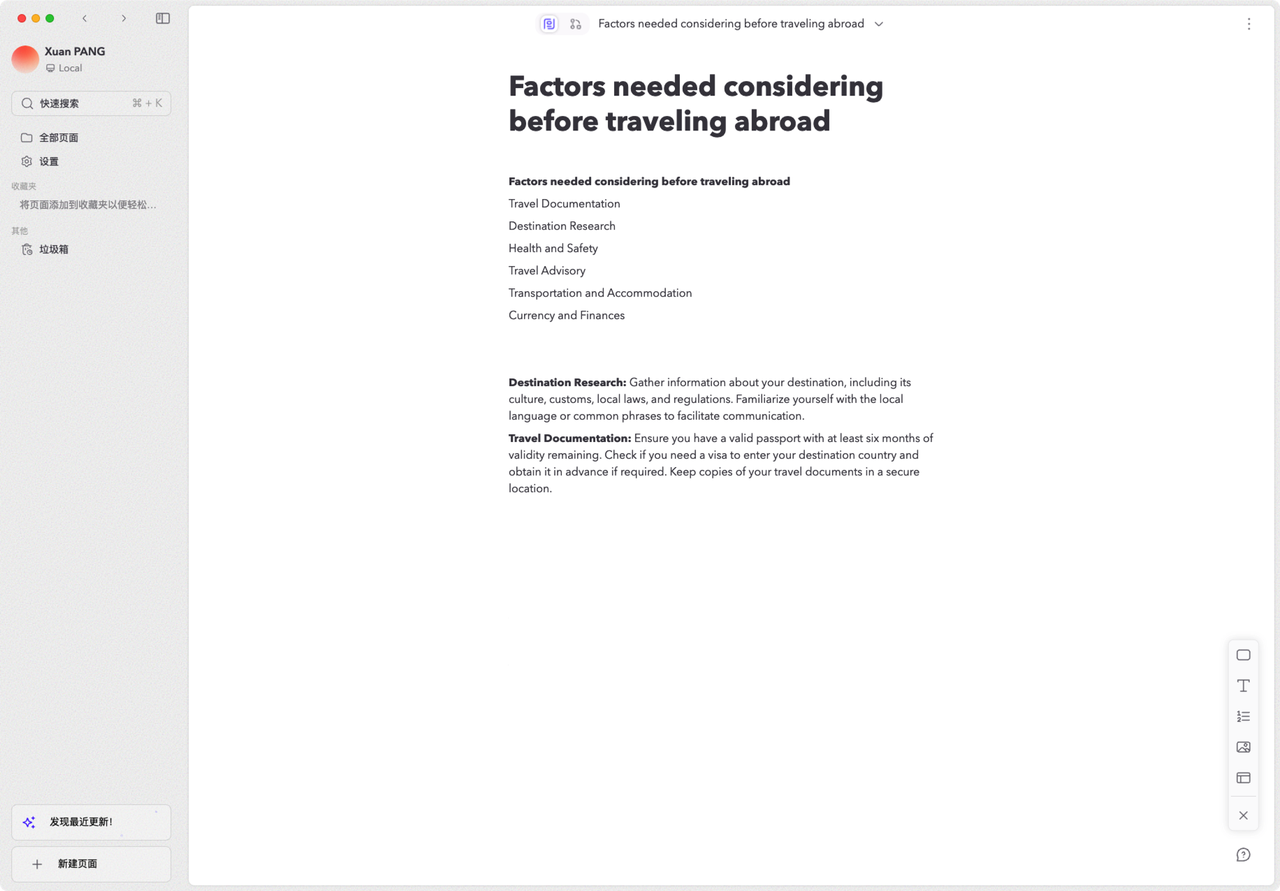 Free, Privacy First, and Open-Source: AFFiNE is available as a free tool, making it accessible to anyone who wants to boost their productivity with mind maps. It prioritizes privacy, ensuring that your data remains secure and confidential. Furthermore, as an open-source platform, AFFiNE provides the advantage of customization. Users have the freedom to tailor the tool to their specific needs and preferences, enhancing the overall user experience. Try it online: AFFiNE:There can be more than Notion and Miro.
Free, Privacy First, and Open-Source: AFFiNE is available as a free tool, making it accessible to anyone who wants to boost their productivity with mind maps. It prioritizes privacy, ensuring that your data remains secure and confidential. Furthermore, as an open-source platform, AFFiNE provides the advantage of customization. Users have the freedom to tailor the tool to their specific needs and preferences, enhancing the overall user experience. Try it online: AFFiNE:There can be more than Notion and Miro.
For more things related to AFFiNE, come and check out the website: AFFiNE — All In One KnowledgeOS
2.XMind

Ease of Use: ⭐️⭐️⭐️⭐️ Visual Appeal: ⭐️⭐️⭐️⭐️ Functionality and Features: ⭐️⭐️⭐️⭐️ Price: $0 to $5.99 per month
XMind is a popular mind mapping tool that empowers individuals and teams to visually organize their thoughts and ideas. It offers a range of features to enhance brainstorming, planning, and creative thinking processes. Here's an introduction to XMind and its key features:
Customizable Elements: With XMind, you can customize the elements of your mind maps, such as colors, fonts, shapes, and icons. This enables you to create visually appealing and personalized mind maps that suit your style and preferences.
Templates and Themes: XMind provides a collection of pre-designed templates and themes that can be used as starting points for your mind maps. These templates cover a wide range of topics and allow you to jumpstart your brainstorming or planning process.
3.Miro

Ease of Use: ⭐️⭐️⭐️⭐️ Visual Appeal: ⭐️⭐️⭐️⭐️ Functionality and Features: ⭐️⭐️⭐️⭐️⭐️ Price: $0 to $16 per month
Miro is a collaborative online whiteboard platform that enables teams to work together visually, regardless of their location. It provides a digital canvas where teams can ideate, brainstorm, plan, and organize their thoughts and ideas in real-time.
Real-Time Collaboration: Miro excels in collaborative work. Multiple team members can simultaneously work on the same mind map, making it ideal for brainstorming sessions, group discussions, and remote team collaboration. Changes are instantly visible to all participants, fostering seamless collaboration and idea sharing.
Multi-Media Support: Miro supports the inclusion of multimedia elements in your mind maps. You can add images, videos, PDFs, and external links to enrich your maps with relevant content and references. This feature enhances the visual appeal and effectiveness of your mind maps.
Presentation and Export Options: Miro allows you to present your mind maps in real-time, making it convenient for team meetings, workshops, and client presentations. You can also export your mind maps as PDFs, images, or editable files to share or use in other contexts.
4.ClickUp

Ease of Use: ⭐️⭐️⭐️⭐️⭐️ Visual Appeal: ⭐️⭐️⭐️ Functionality and Features: ⭐️⭐️⭐️⭐️ Price: $0 to $19 per month
ClickUp is a versatile project management and productivity platform designed to streamline workflows and improve team collaboration. It offers a comprehensive set of features that allow teams to plan, organize, and track tasks and projects efficiently.
Task Management Integration: ClickUp seamlessly integrates mind maps with task management functionalities. You can convert branches and sub-branches into actionable tasks, assign them to team members, set due dates, and track progress. This integration ensures a seamless transition from ideation to task execution.
Automation and Workflow Automation: ClickUp offers powerful automation features that can streamline your mind mapping process. You can automate repetitive tasks, set up reminders, notifications, and triggers based on specific conditions, enhancing efficiency and productivity.
5.Coggle

Ease of Use: ⭐️⭐️⭐️⭐️ Visual Appeal: ⭐️⭐️⭐️ Functionality and Features: ⭐️⭐️⭐️ Price: $0 to $8 per month
Coggle is an intuitive and user-friendly online mind mapping tool that helps individuals and teams visualize and organize their thoughts, ideas, and information. With its simple and intuitive interface, Coggle makes it easy for users to create and collaborate on mind maps, making it a valuable tool for brainstorming, planning, and organizing various projects and concepts.
Version History and Undo/Redo: Coggle keeps a track of all changes made to your mind maps, allowing you to access previous versions and revert back if needed. The undo/redo functionality ensures that you can easily modify and refine your mind map without any concerns.
Seamless Sharing and Publishing: Coggle makes it easy to share your mind maps with others. You can invite collaborators by simply sharing a link, and they can join in real-time. You can also publish your mind maps publicly or privately, allowing you to easily share your ideas with a broader audience.
Conclusion
The five mind map examples showcased in this discussion demonstrate the versatility and applicability of mind maps across various domains. To further enhance the mind mapping experience, there are several popular tools available. AFFiNE, XMind, Miro, ClickUp, and Coggle are among the top choices, each offering unique features and functionalities to cater to diverse user needs. These tools enable customization, collaboration, offline accessibility, and seamless integration of databases, among other capabilities, to enhance productivity and support the creation of engaging mind maps.
Whether you are a student, professional, entrepreneur, or team leader, incorporating mind maps and utilizing the right mind mapping tool can greatly enhance your ability to brainstorm, plan, and visualize ideas. By leveraging the power of mind maps and exploring the features offered by these popular tools, you can unlock your creative potential, improve decision-making processes, and effectively organize information for increased productivity and success.
Specifically, AFFiNE is still in its beta, but we are continuing to build to a more feature-rich and stable build. Come and join us on our journey over on our media platforms.
-
Official Website: https://affine.pro/
-
Discord: https://discord.gg/Arn7TqJBvG
-
Telegram: https://t.me/affineworkos